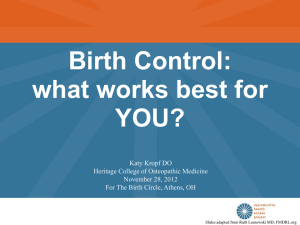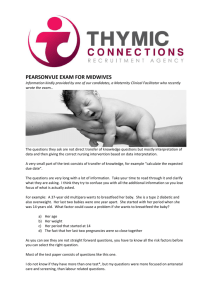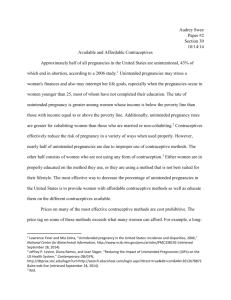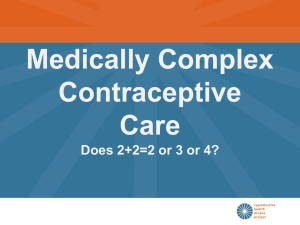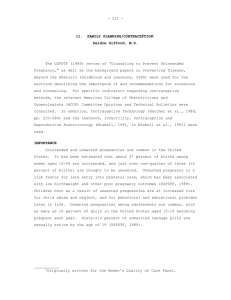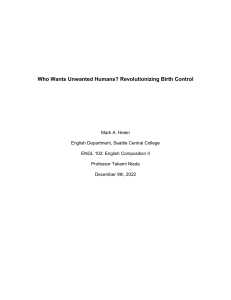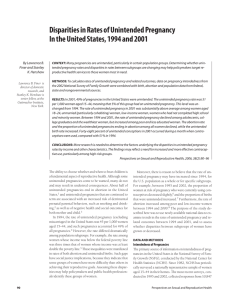ppt Patient-centered Contraception
advertisement
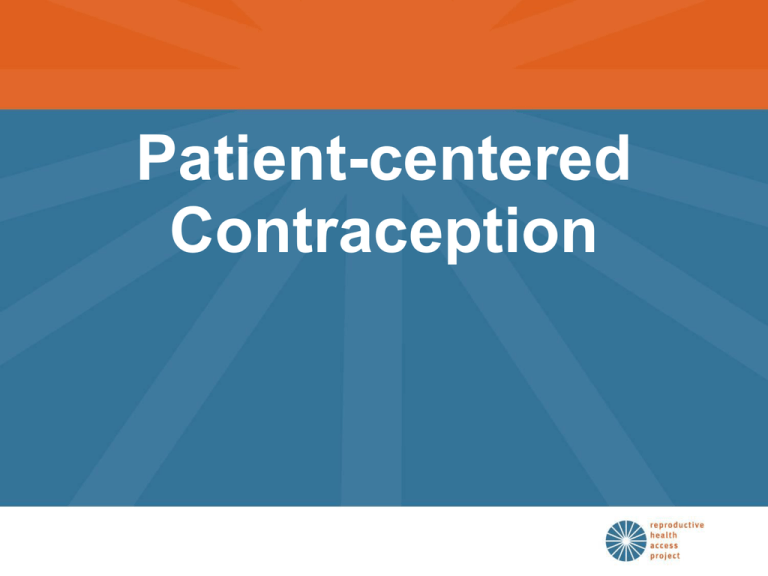
Patient-centered Contraception Nearly half of pregnancies in the United States are unintended. Unintended, occur earlier than desired 29% Unintended, occur after desired family size reached 20% Intended - 51% Approximately 6.4 million pregnancies per year Outcomes of Unintended Pregnancies Approximately 3.0 Million Annually Most unintended pregnancies occur when women fail to use contraceptives or use their method inconsistently. Half of women at risk are not fully protected from unintended pregnancy. Nonuse all year 8% Inconsistent use - 27% Consistent, long-acting method use 50% At-risk gap use 15% 28 million U.S. women at risk for unintended pregnancy Unintended pregnancy rate by race/ethnicity/income 180 160 140 Unintended pregnancies per 1,000 women 120 all white latina black 100 80 60 40 20 0 Below poverty level Above poverty level Why do women experience unintended pregnancies? Efficacy: Numbers & Categories Table “Less Effective Methods” Effectiveness Group No Method Less effective Family Planning Typical-Use Rate Perfect-Use Rate Method of Pregnancy of Pregnancy No method 85% 85% Male latex condoms 14% 3% Diaphragm 20% 6 Cervical cap 20%-40% 9%-26% Female condoms 21% 5% Spermicide 26% 6% Withdrawal 19% 4% Fertility Awareness 20% 1%-9% Yolanda 17 year-old high school senior Requests pregnancy test, birth control pill Had unprotected sex 4 days ago Urine pregnancy test is negative. What do you do next? Emergency Contraception: Levonorgestrel (Plan B) Take at once, up to 5 days after unprotected sex. Lowers risk of pregnancy by 58-89% Levonorgestrel EC: Mechanism of Action Inhibits ovulation Does NOT cause abortion Ulipristal acetate: a new emergency contraceptive option Decreases risk of unintended pregnancy by about 90% Maintains nearly full efficacy up to 5 days after unprotected intercourse Hormonal Contraceptives What is needed before prescribing? Medical history REQUIRED Pap smear Pelvic/breast exam STI testing Hemoglobin NOT REQUIRED Blood pressure RECOMMENDED Hormonal Contraceptives Which women/teens can’t use estrogen? Estrogen contraindications: • Migraine with aura • Uncontrolled hypertension • Postpartum < 6 weeks • History of DVT Smoking: NOT a contraindication in women/teens under age 35 Yolanda is eligible for the pill. When should she start? Advance EC prescrbing Should Yolanda get a prescription for EC, too? . Jessyka 21 year old waitress Had a medication abortion 1 week ago in your office Has severe PMS symptoms OCs helped just a bit Extended Cycle Regimens Liz 21-year-old healthy college student Takes oral contraceptive, but forgets pills often Has trouble getting refills while at college, and now the pills are too expensive Adherence with OCs: What Women Do! Percent of Women (%) Number of pills missed Potter L et al. 1996. What are the common reasons for missing pills? Back to Liz… She would like to try something easier to remember. What information do you need? Efficacy: Numbers & Categories Table “Effective Methods” Effectiveness Group Effective Family Planning Typical-Use Rate Perfect-Use Rate Method of Pregnancy of Pregnancy Birth control pills 8% 0.1%-0.5% Transdermal patch Unknown (8%) 0.3%-0.8% Vaginal ring Unknown (8%) 0.1%-0.5% Estrogen/progestin vaginal ring • Active for at least 3 weeks • Lowest estrogen dose: 15 mcg / day • Same efficacy and contraindications as OCs • May remove for up to 3 hours • QuickStart same as with OCs Estrogen / Progestin Patch • • • • 1 patch weekly for 3 weeks, then one week off Same efficacy & contraindications as OCs OK to shower, swim, exercise with patch on Failures in trials were in women over 198 pounds, but still rare • Higher risk of clots? Conflicting studies… Gallo MF, et al. Cochrane Reviews. 2003, Issue 1. Art. No. CD003552. Jick S, et al. Contraception 73 (2006) How many refills should we give Liz? Resa 16 years old Doesn’t want to get pregnant until she finishes school Wants contraception that she can hide from her mom What are her choices? Highly Effective Methods NOT USER DEPENDENT Effectiveness Group Highly Effective (for all users) Family Planning Typical-Use Rate Perfect-Use Rate Method of Pregnancy of Pregnancy Male and female sterilization 0.2%-0.5% 0.1%-0.5% Implants 0.1% 0.1% Hormone shot 0.3% 0.3% Intrauterine devices 0.8%-2% 0.6%-1.5% Progestin-Only Injection Hatcher, R et al. A Pocket Guide to Managing Contraception, 2007-2008 Depo Provera & Bone Density Weighing risks and benefits: No need to restrict Depo Provera use Amy 21-year-old G4P2 New boyfriend wants her to get pregnant, but she doesn’t want a child now. Intrauterine Devices IUD Myths Debunked IUDs can be used safely by nulligravid women and teens! IUDs DO NOT raise risk of PID. IUDs DO NOT raise risk of infertility. IUDs DO NOT raise risk of ectopic pregnancy. IUD Myths Debunked IUDs DO NOT cause abortion. OK to insert IUD at any point in the menstrual cycle. OK to insert immediately post-partum or following surgical abortion OK to test for STIs at time of insertion (& treat infections with IUD in place) Blanca 36-year-old G6P4 Has fibroids and anemia Progestin IUD (MIRENA) Progestin Implant • Highly effective and rapidly reversible • Discreet • Not user-dependent • Contain no estrogen • Can be used during lactation • Active hormone: etonogestrel (68 mg) Reinprayoon. Contraception 2000 Features of Progestin Implants Causes spotting Requires certified clinician visits for insertion and removal Counseling to Enhance Adherence • LISTEN to her ideas about the best method. • EXPLORE lifestyle issues that may impact adherence. • ENCOURAGE her to call you with problems/concerns. Impact of Choice % of Women Continuing Contraceptive Use at 1 Year Pariani. Stud Fam Plann, 1991 1991 Inconsistent pill use is linked to: low level of satisfaction with provider & low continuity of care. 60 51 50 47 40 36 34 30 20 10 0 Very satisfied w/ provider Not very satisfied w/ provider Usually see same clinician Do not usually see same clinician Percent of pill users who missed one or more pills during the past three months Office barriers to adherence Feeling unable to call a provider with questions is linked to contraceptive non-use. % of at-risk women experiencing contraceptive non-use in the past year Electronic Health Records Take-home message: Be pro-active with contraception! DE-LINK pap smears from birth control prescriptions. ROUTINELY prescribe 1-year supply with 3 packs at a time. Use Quickstart. Ask about contraceptive needs at all types of visits. Emphasize high-efficacy methods, but honor women’s choice whenever possible. References and Resources • Hatcher et al, Contraceptive Technology 2007 • Managing Contraception – book online @ www.managingcontraception.org • Medical Eligibility Criteria for Contraceptive Use 2010 by WHO www.who.int/reproductive-health • Association of Reproductive Health Professionals www.arhp.org • Alan Guttmacher Institute www.agi-usa.org • Planned Parenthood www.plannedparenthood.org • The Cochrane Collaboration www.cochrane.org • www.Not-2-Late.com • Reproductive Health Access Project www.reproductiveaccess.org
